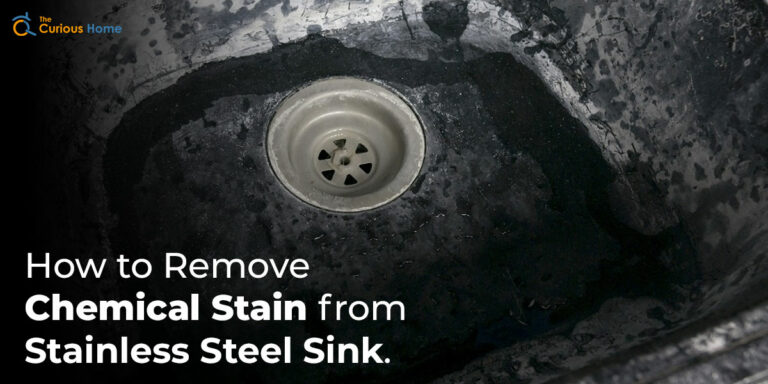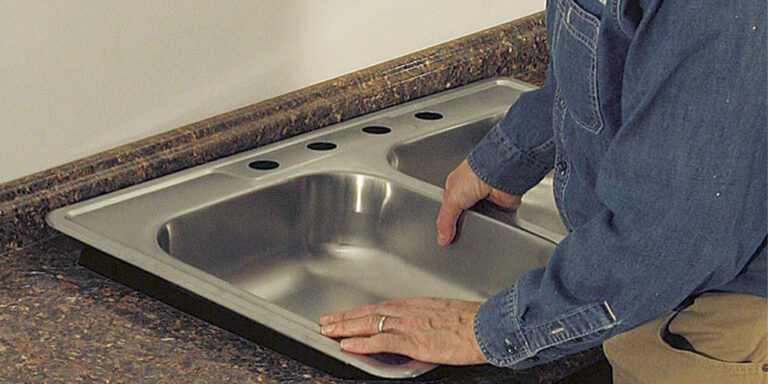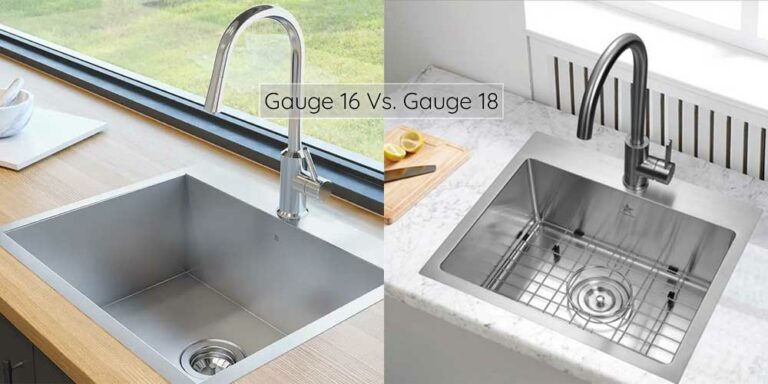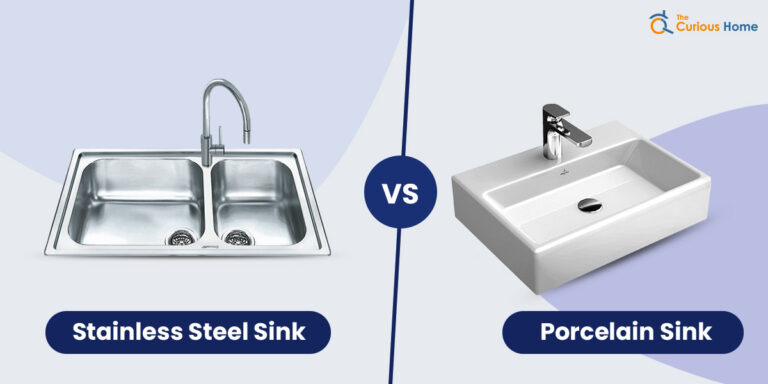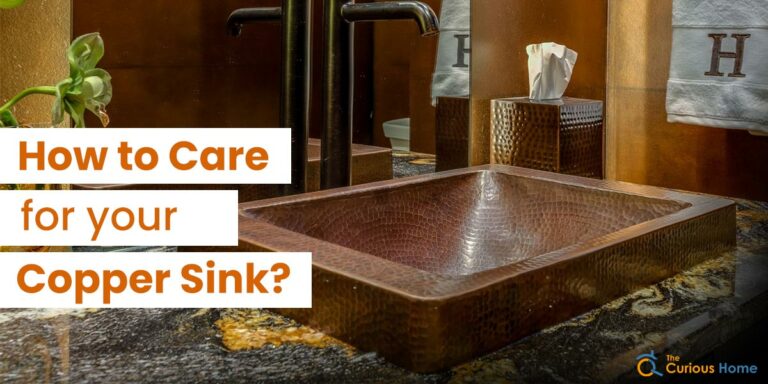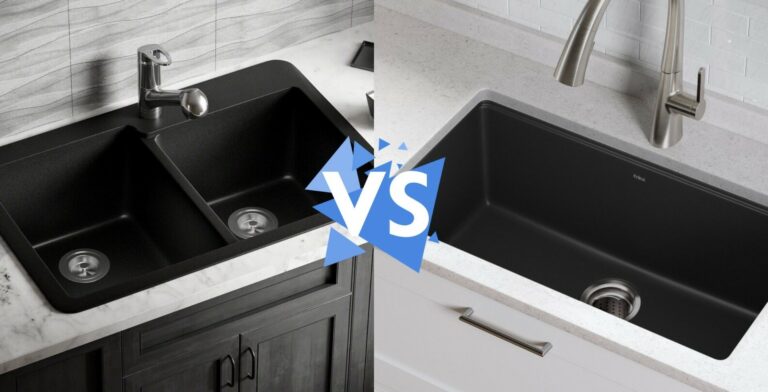Ceramic Vs Porcelain Sink | Kitchen Sink Material Guide
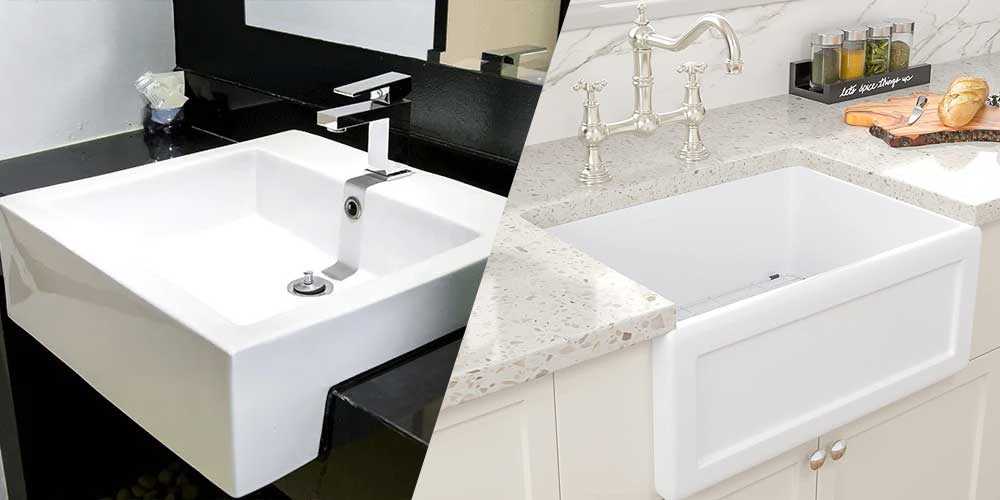
While sinks are unquestionably functional in character, they have progressed far beyond being simply useful and convenient. Sinks are available in thousands of different shapes, sizes, and colors in recent times. The sink is prevalently the aesthetic centerpiece of many bathrooms and kitchens, as well as a significant financial investment for some folks. This apart from choosing a sink that complements the visual appeal of your layout and ambience, functionality and convenience must also be taken into account.
Ceramic and porcelain are the two prominent sink materials, besides stainless steel, copper, granite, fireclay and others. They are both very similar, which causes people to become perplexed when renovating their bathrooms. Although there are only a few factors that contribute to the ceramic vs porcelain sink debate, they make a significant difference in the product’s appearance, quality, durability, and convenience. So in this article, we are trying to bring forth all the porcelain vs ceramic sink aspects that will help you figure out which one is best suited for your kitchen or bathroom. So keep reading to know more.
What Is A Ceramic Sink?
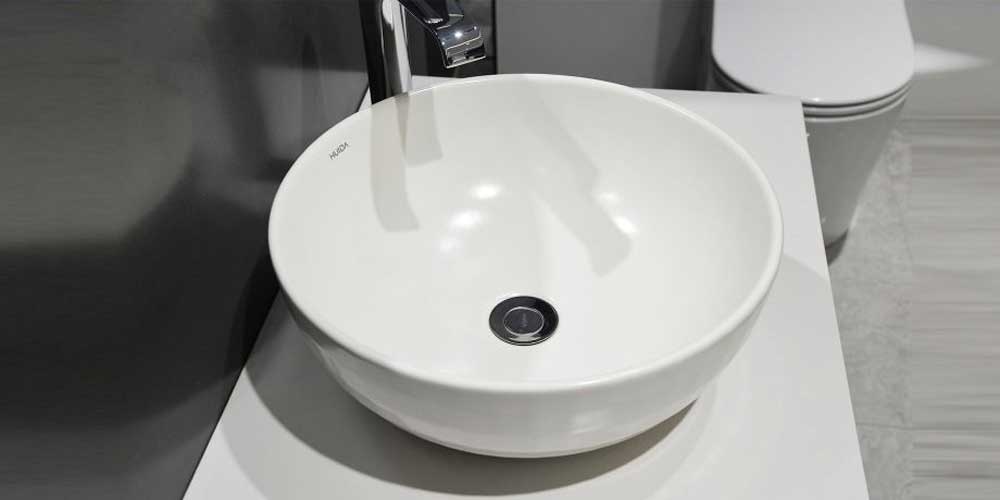
Ceramic sinks are a familiar sight in kitchens throughout the world. Ceramic sinks are ideal if you prefer a classical, cottage-style kitchen. A great match for vintage-style wood cabinets and countertops. Ceramic sinks are created by combining clays, fillers, and fluxes that are combined and welded together via the firing process. No two ceramic sinks are ever exactly the same because of the firing process and the natural elements used.
Many people are unaware that ceramic is a natural substance made from easily accessible crude materials such as clay, kaolin, quartz, and feldspar. This means that ceramic sinks are sturdy, long-lasting, and eco – friendly in terms of both production and disposal. Ceramic kitchen sinks are perhaps the most durable and easy to maintain sinks for your kitchen, as they are highly resistant to heat, scraping, and household acids.
What Is A Porcelain Sink?
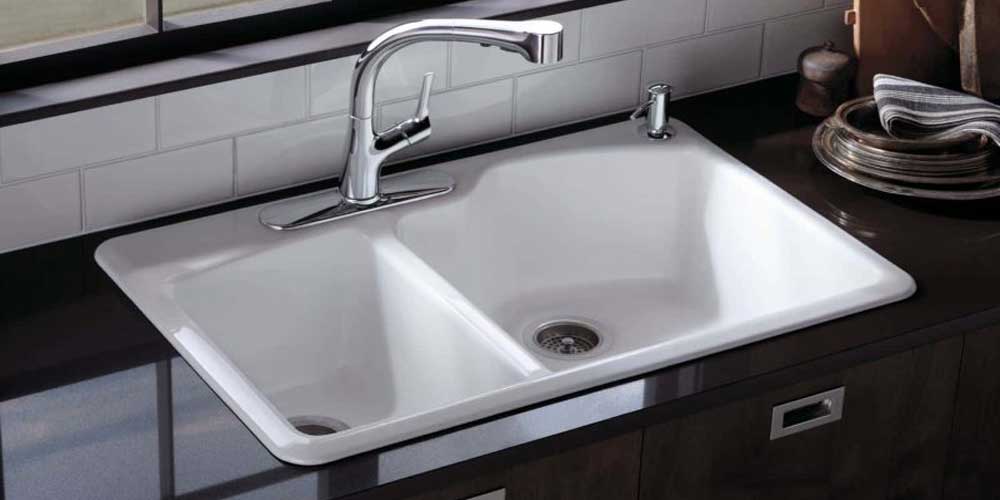
Porcelain is essentially ceramic that has been fired at high temperatures to create a smooth, nonporous surface. Porcelain is composed primarily of kaolin, a fine silicate-based clay mineral. This is sculpted or moulded to the desired shape, then covered with a glaze and fired at an extremely high temperature (between 1,200°C and 1,400°C). The firing essentially causes a physical reaction, transforming the texture of the sink into the hard, polished glass finish that we are all familiar with.
Porcelain sinks have a very elegant appearance. The greatest part about a porcelain sink is that due to its soft, dense material, it can be formed into any shape. Porcelain sinks have a very solid feel to them and are resistant to extreme hot and cold temperatures. However, because porcelain is essentially glass, it can be scraped, smudged, or damaged by sharp or tough objects.
How to Tell Ceramic And Porcelain Sinks Apart?
Porcelain and ceramic are very similar. An amateur will have a difficult time distinguishing the very for the first time. Having a look for the product code and then doing some internet research is one of the quickest and easiest ways to determine what material your sink is made of. Precisely, the instruction manual for your sink should tell you what it’s made of, but if you don’t have one, the product code must suffice.
Examine the glaze carefully: if it is chipped, the white or tan base of the wall will be visible. This is a dead giveaway that the sink is made of ceramic. Glazing is not always used on porcelain sinks. The color of most high-quality porcelain sinks will be consistent across the top, body, and bottom of the sink. The difference is that ceramic must be treated with a glaze to be completely waterproof, which gives it that shiny and pale glossy surface that porcelain has.
Ceramic Vs Porcelain Sink | Which Is A Better Option?
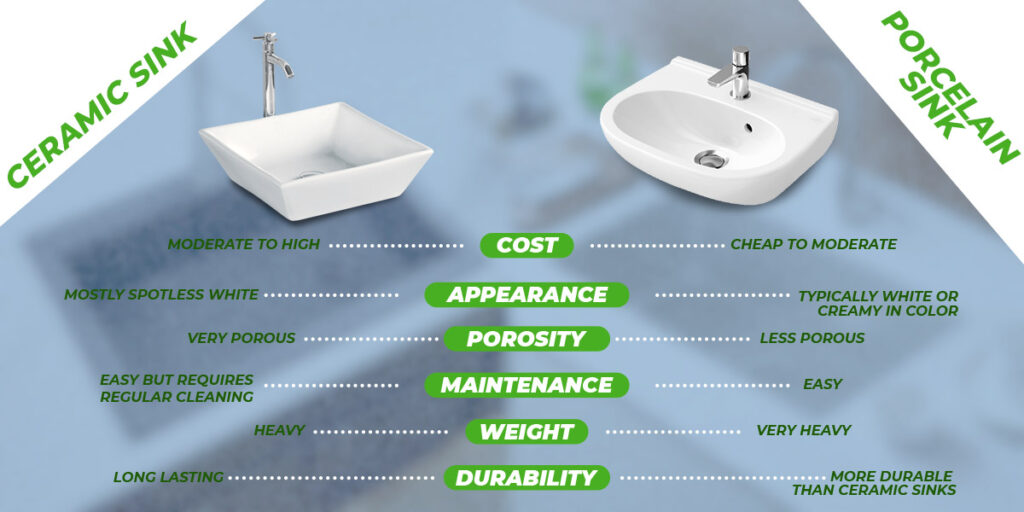
You might have wondered countless times if it is porcelain or ceramic better while trying to choose a new sink. Well, it might undoubtedly be confusing as they both seem the same. There are some underlying factors that you should consider while picking one of them. So here are the factor that you should keep in mind for your convenience before installing any one of them.
1. Cost
Cost of Porcelain vs. Ceramic sinks are very affordable and almost similar in their prices. When it comes to cost, porcelain is a bit cheaper than ceramic. Porcelain is one of the most affordable sink materials on the market right now due to their density differences. You can get a top-quality porcelain sink for a few hundred bucks. High-end ceramic sinks, depending on the style and design, can cost a lot more than high-end porcelain sinks. If you go for premium ceramic sinks, they can cost more than the best porcelain sinks available in the market right now.
2. Maintenance
The ceramic surface is extremely smooth and completely waterproof. Dirt and grime will not be able to work its way into it because there are no small crevices or cracks. This is why maintaining ceramic sinks is so simple. To prevent stains from appearing, simply wipe the wet ceramic surface with a clean, dry towel. You can even use all-purpose cleansing products and keep the original shine of the ceramic bathroom sink for a longer period of time. To avoid chipping away at the decorated surface of ceramic sinks with hand-painted designs, avoid using abrasive cleaning materials. It is also advised to keep the ceramic surface nice and clean and to wipe away any remnants of soap, as this is the most common cause of staining in ceramic sinks.
Porcelain, like ceramic sinks, should not be cleaned with abrasive materials. Simply use liquid soap or a gentle all-purpose cleaner. Remember to clean the surface area dry after cleansing the sink to prevent stain buildup from remaining soap streaks. You must also avoid using highly acidic cleaning solutions because they can destroy the surface of the porcelain over time. To summarize, both require an equal amount of maintenance to preserve their luster and durability. Ceramic sinks, on the other hand, require thorough cleaning on a regular basis.
3. Appearance
Ceramic is a dense material with elegant designs that enhance the beauty of the bathroom’s interior. The sink adds a new look to the bathroom. A ceramic kitchen sink’s most common appearance is spotless white, but they are also available in other colors. Consider a black or stone ceramic sink if you really want to draw attention to your sink. These sinks are also available in a variety of shapes and designs. Ceramic sinks come in single, double, and even triple bowl configurations, and you can even have one custom made.
Porcelain sinks look stunning and can be decorated with unique patterns and colored glazes for eye-catching results. They are frequently designed with overflow drains or weirs incorporated into the layout and can be set up to fit any arrangement. Similarly, they are available in both top-mount and undermount versions. Porcelain sinks are typically white or creamy in color, and you can get them in a variety of other colors to match your decor.
4. Porosity
Another significant distinction between ceramic and porcelain sinks is their porousness. Because of all the manufacturing process of ceramic, it is very porous when not graved and thus absorbs some water. Your ceramic sink will become very brittle if it absorbs too much water. It will begin to crack and eventually break. As a result, ceramic sinks must be coated in order to be completely waterproof; otherwise, you will have challenges.
Because of the manufacturing process, porcelain is much denser and less porous, or even non-porous, and thus does not absorb any water, and it does not even require a coating to achieve this property. The fact of the matter is that porcelain is far more naturally waterproof than ceramic, making it a much better choice for its sink.
5. Weight and Mounting Options
Ceramic sinks are available in a variety of mounting configurations. Pedestal sinks, undermount sinks, and Belfast style sinks are among the most popular choices. Ceramic sinks are popular because of their durability, variety of design and color, and ultimate aesthetic appeal. They are widely used and have long been a prominent choice for new infrastructure and renovating projects. Also, porcelain sinks are used in more than 90% of the vanity installations. They are available in drop-in, undermount and apron-front configurations. But they are not recommended for kitchen sinks due to their proclivity to break or chip when subjected to heavy impact, but they are ideal for vanities.
When it comes to weight, both of these sinks are quite heavy due to the nature of their construction materials. However, porcelain sinks are slightly heavier than ceramic sinks because they are made of either thick gauge cast iron or steel that has been deposited in a baked-on porcelain enamel. The weight complicates installation, with drop-in porcelain sinks being the most straightforward. The installation of an undermount porcelain sink can be much more difficult. Learn the differences between undermount and drop-in installation here.
6. Durability
Ceramic sinks are extremely long-lasting, especially when it comes to scratch resistance. Ceramic sinks are stain-resistant and easy to maintain, and they can be cleaned with everyday household cleaners. They’re also chip-resistant. Having said that, a ceramic sink will shatter if subjected to a high impact. They are extremely sensitive and subject to chips, cracks, and scratches. However, this does not render ceramic sinks unsuitable for basic daily use.
Having said that, porcelain is the more durable of the two. It is a much more durable element because it is burned at a higher temperature and subjected to higher pressures during the production process, as well as the inclusion of other materials like metals. Porcelain is much more scratch and chip proof than ceramic, as well as being more highly durable. Another factor to bear in mind is that porcelain might easily be chipped. Dropping a sharp or heavy object on a porcelain kitchen sink can chip the enamel. When bleach and other acidic substances are left undisturbed for an extended period of time, they can destroy the surface and glaze of the porcelain.
Related:
Cast iron Vs Stainless Steel Sinks
Granite composite vs stainless steel sinks
Verdict | Is Porcelain Or Ceramic Better As A Sink Material?
A porcelain sink is the one to go with if you’re looking for a low-cost, minimal sink. They are also more durable. Ceramic sinks, on the other hand, are available in far more styles and colors than porcelain sinks, which are typically only available in the most basic and simplistic designs.
So, in the end, porcelain is more sturdy and functional, whereas ceramic may look a little better. Furthermore, if your porcelain sink develops a defect, it is difficult and expensive to repair. Ceramic sinks, on the other hand, are less expensive and easier to repair than porcelain sinks. The choice is yours to make!

